




Confidence Worth Celebrating
Welcome to Iconique Aesthetics

Everyone deserves to look and feel ICONIQUE.
Visit our Medspa in Costa Mesa, CA
We believe in maintaining your natural beauty and elegance, not altering it. Come see why thousands of patients choose us for all their medical aesthetics needs.
Welcome to Iconique Aesthetics. Here at Iconique, we believe in taking a comprehensive approach to your aesthetic concerns, offering the latest evidence-based anti-aging and regenerative procedures such as Botox, Dermal Fillers, Kybella, Sculptra, DiamondGlow, Microneedling, Moxi, and BBL laser treatments. Each of our highly skilled medical providers are trained in the latest and most advanced techniques offered in medical aesthetics. We proudly service thousands of clients in the Orange County and Los Angeles areas and welcome many patients who travel nationwide and beyond to meet and be treated by our talented providers. Visit our beautiful MedSpa in Costa Mesa, California.

Injectables & Fillers

Hair & Skin Treatments
“We believe in maintaining your natural beauty and elegance, not altering it. Let us be your aesthetic destination; everyone deserves to look and feel ICONIQUE.”
–MARISSA MANIACI, FOUNDER & LEAD INJECTOR
Marissa Maniaci, RN | Founder & Lead Injector
An icon in her own right, Marissa Maniaci, RN, is the heart and soul of our practice.
With over 9.5 years of experience as an injector, Marissa is passionate about helping clients achieve their aesthetic goals. She specializes in a wide range of treatments, including Botox, fillers, and other non-surgical procedures. Beyond her professional expertise, Marissa is a vibrant and enthusiastic individual. When she's not working, she enjoys traveling, exercising, cooking, and playing piano. Marissa is also a devoted wife and new momma. Her love for her family extends beyond her immediate circle, as she maintains close relationships with both her and her husband's families.
Marissa's dedication to her MedSpa clients, combined with her warm and friendly personality, is the inspiration behind our team’s collective passion for what we do. She is obsessed with providing an exceptional experience and ensuring that every client feels comfortable and confident in choosing Iconique for their aesthetic care.

Injecting Confidence
The Iconique Philosophy
At Iconique Medical Aesthetics in Costa Mesa, CA, we believe in empowering you to embrace your natural beauty. Our team of skilled providers is dedicated to crafting a personalized aesthetic journey that celebrates your unique features.
We begin with a comprehensive facial consultation to develop a tailored plan encompassing injectables, skin treatments, and skincare recommendations for the entire year. Our commitment to excellence goes beyond our treatments. We stay at the forefront of the latest trends and advancements in aesthetic medicine, ensuring you receive the most innovative and effective procedures suited to your goals. By combining our expertise with a personalized approach, we strive to unlock your inner radiance so that you can exude the kind of indefinable confidence that precedes you. At Iconique Medical Aesthetics Costa Mesa patients aren't just clients; they're partners in curating their own detailed and sustainable beauty regimen.
Top-ShelfBeauty
We’ve Got Your Beauty Needs Covered
We specialize in full facial Aesthetics. Our highly skilled providers offer a variety of cosmetic procedures including Botox, dermal fillers, Kybella, Sculptra, PRP, PRF, SkinPen microneedling, broadband light (BBL), MOXI, and DiamondGlow facials. We use proven methods and advanced techniques to help our clients reach their beauty goals to feel like the most ICONIQUE version of themselves.

Impeccable Proportions
Facial Balancing in Costa Mesa, CA
Facial balancing is a holistic approach to restoring facial harmony and symmetry. By identifying and addressing imbalances in the facial structure it can create a more aesthetically pleasing appearance, reduce tension in the facial muscles, relieve pain associated with conditions like TMJ, promote relaxation and stress reduction, and improve skin health by stimulating blood flow to the facial tissues. Facial balancing can help you achieve a more balanced and youthful-looking face, as well as a sense of overall well-being at our Costa Mesa MedSpa.

Harness Your Natural Youth
PRF EZ Gel in Costa Mesa, CA
PRF EZ Gel is a cutting-edge aesthetic treatment that harnesses the body's natural healing power. Derived from your own blood, this innovative gel contains concentrated platelets and growth factors that stimulate natural collagen production and tissue regeneration. PRF EZ Gel is minimally invasive and highly effective for addressing various skin concerns, including fine lines, wrinkles, volume loss, and acne scars. It offers long-lasting results, minimal downtime, and a reduced risk of allergic reactions, delivering an overall easy and satisfying experience.

Expert Precision
Laser Treatments in Costa Mesa, CA
Moxi and BBL are advanced laser technologies that offer effective solutions for various skin concerns. Moxi is a gentle laser treatment that targets fine lines, wrinkles, and uneven skin texture. It stimulates collagen production, improving skin elasticity and reducing the appearance of aging. BBL, on the other hand, is a more intense laser treatment that can address a wider range of skin issues, including sun damage, age spots, rosacea, and acne. With Moxi and BBL, you can achieve comprehensive complexion renewal for a fresh look and renewed confidence.

Fresh & Flawless
Facials in Costa Mesa, CA
Facials are a luxurious and customizable way to improve skin health and appearance. Our full menu of facial treatments allows you to address various skin concerns, including acne, dryness, wrinkles, and hyperpigmentation in a way that suits your goals, lifestyle, and complexion needs. During a facial, your skin is cleansed, exfoliated, and treated with nourishing products. For advanced results, consider microdermabrasion or chemical peels, which can help remove dead skin cells, stimulate cell turnover, and reduce the appearance of fine lines and wrinkles.

Sumptuous & Supple
Lip Filler in Costa Mesa, CA
Lip filler can significantly enhance the appearance of your lips. By adding volume and definition, it can create a more balanced and youthful facial profile. Some of the key benefits of lip filler include improved appearance, increased confidence, natural-looking results, minimal downtime, and customizable results. Lip filler can help to address concerns such as thin, uneven, or aging lips, providing a more aesthetically pleasing and rejuvenated appearance. Additionally, the procedure is convenient, taking only about 30 minutes to perform with minimal recovery.

Stay Iconique.
Botox in Costa Mesa, CA
Botox is a mainstay aesthetic treatment used to reduce the appearance of fine lines and wrinkles. It works by temporarily relaxing facial muscles, smoothing out lines, and creating a more youthful appearance. Botox offers a minimally invasive and convenient solution for preventing and reversing the signs of aging, providing natural-looking results that last months at a time. Botox can also be used to achieve a subtly lifted brow for an energetic, youthful look without surgery or downtime.

Our Diamonds Are Your Best Friend
Allergan Diamond Provider in Costa Mesa, CA
Iconique Medical Aesthetics is proud to feature a team of exceptionally skilled and trustworthy injectors. As an Allergan Diamond Provider, a recognition bestowed upon those who demonstrate exceptional expertise in administering Allergan products, you can undergo treatment with the confidence that you have selected the best of the best injectors.
We also utilize cutting-edge techniques such as PRF EZ Gel, a growth factor injection that enhances healing and promotes natural-looking results. To ensure the highest level of quality, all of our injectors undergo rigorous training by globally recognized experts in the field. With their expertise and dedication, you can trust that Iconique Medical Aesthetics will provide you with exceptional results and a personalized experience.

Be your own icon.
Custom Treatment Plans & Packages
Browse our featured packages and patient transformations, and get the inspiration you need to begin planning your unique MedSpa journey.
Iconique Medical Aesthetics is dedicated to crafting personalized treatment plans that cater to your unique aesthetic goals. Our team utilizes advanced therapies and innovative treatment packages to deliver an elite-level experience and impeccable results. Through a thorough consultation, we assess your needs and recommend the most effective treatments to achieve your desired outcome. Our goal is to provide a seamless and transformative experience that leaves you feeling confident and radiant.

Iconique Lips
Starting at: $850
Are you looking to plump & shape your lips to perfection? This beauty bundle has everything you need to get your lips in shape. This treatment is completely customized to give you your desired result, so whether you are looking for MAX plumping, a defined shape, or just a soft natural plump we can help you reach your beauty goals!

Iconique Contour
Starting at: $3500
This is the ultimate package to SLIM and CONTOUR the lower face and jawline. This package combats the double chin using Kybella to permanently remove fat and Voluma to sculpt the chin and jawline. Botox is also used to further slim the jawline and tighten the neck.

Beauty Icon Facial Balancing
Starting at: $4000
Everyone deserves to look & feel ICONIQUE! This is our most comprehensive package using cutting-edge techniques to address full facial balancing & provide you with the most beautiful, natural results. No two clients are the same; let us customize a treatment plan to meet ALL of your beauty goals!






